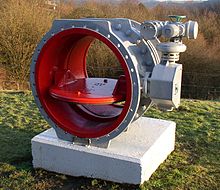Butterfly valve

The butterfly valve is a valve for controlling the flow of a fluid in a pipeline . With this design, the flow is changed by a disk that can be rotated in the flow cross-section. When the flap is fully open, the disc is aligned parallel to the direction of flow.
For smaller nominal sizes, the valve disc is rotated by a manually operated lever , for larger nominal sizes by a hand crank with gear ; actuation by a drive motor or a hydraulic or pneumatic drive is also possible. Depending on the fluid, very high torques of several tens of thousands of Newton meters (Nm) have to be used to rotate the flap .
Butterfly valves are well suited for throttling the fluid flow ( throttle valve ), but have a certain flow resistance even when fully open . Your space requirement within the pipeline is very small. The intermediate flange design , which can be clamped between two flanges , has only a short overall length.
species
Differentiation according to geometry
There are essentially four types of butterfly valve:
- the centric design ( pivot point is in the middle of the seat and in the middle of the pipeline)
- simply eccentric , in which the valve disc pivot point is shifted out of the plane of the seat along the pipe axis ( flap ball segment )
- double eccentric ones, where the pivot point is also not in the middle of the pipe (e.g. every normal door is a double eccentric butterfly valve.)
- triple eccentric butterfly valves (also the axis of rotation of the seat is not parallel and not symmetrical to the pipe axis ).
Differentiation according to sealing material
Depending on the construction, different sealing materials can be used:
- Elastomer and / or polymer (e.g. PTFE ) (soft-seated butterfly valve)
- Metal (metallic sealing butterfly valves).
While the most inexpensive design of the centric butterfly valve can only be produced with soft-sealing seals, the triple eccentric butterfly valve achieves absolute freedom from friction and can achieve a very long service life in large nominal widths even with metallic seals (switching changes up to 250,000 cycles with full function).
With a soft seal
Resilient seated butterfly valves are designed with nominal widths of up to several meters and low nominal pressure levels , usually up to a maximum of 16 bar , and are suitable for temperatures up to a maximum of 200 ° C. The seals are usually designed as a housing lining made of elastomer, here the maximum temperature of up to 150 ° C is possible, or made of PTFE. The sensitivity of a soft-sealing flap to contamination is low. However, due to the large seat cross-section, even small leaks lead to significant amounts of leakage . The sealing of the axis of rotation from the environment is problematic. Here, leaks often cannot be completely avoided.
With metallic seal
Metal sealing butterfly valves are designed in nominal widths of up to two meters and pressure levels up to 200 bar. The main advantage is the extremely good usability at very low and very high temperatures: −200 ° C for cryogenic applications or +1100 ° C, for example for exhaust flaps on submarines, often. Leakages can also be completely excluded in vacuum applications . Sealing of the shaft by means of a stuffing packing make the valves absolutely tight, even with media such as helium or hydrogen . Metallic sealing flaps, on the other hand, are relatively sensitive to solids in the medium.
Special forms
Double butterfly valves can be used to increase the tightness of large dimensions. Two valve discs, which are actuated in parallel, form an intermediate space to which a barrier medium (air or liquid) is applied.
The non- return valve is a special design of the butterfly valve .
literature
- Ralph-Harry Klaer (Ed.): Practical manual for industrial fittings 2003. Vulkan Verlag GmbH, Essen 2003, ISBN 3-8027-2729-0 .
- Wolfgang Tietze: Handbook Sealing Practice. 3rd edition, Vulkan Verlag GmbH, Essen 2003, ISBN 3-8027-3301-0 .
- Dietmar Rötsch: Reliability of piping systems. District heating and water, Springer Verlag Berlin Heidelberg, Berlin Heidelberg 1999, ISBN 978-3-642-64308-8 .
Web links
- Butterfly valves in municipal water management (accessed on February 19, 2016)
- Erhard Butterfly Valves (accessed on February 19, 2016)
